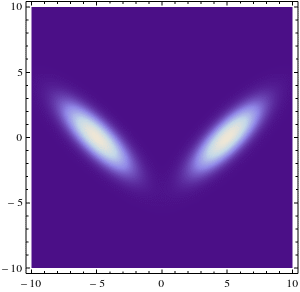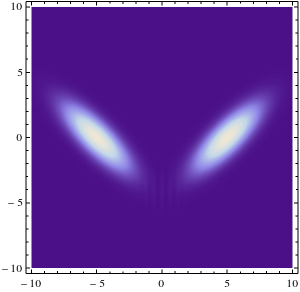Having read this question and answers to it, I've learned that somehow two light beams from independent sources can actually produce interference pattern, if the properties of their sources are good enough.
Now, this conflicts with my understanding of quantum particles. I suppose that interference of independent beams means interference between pairs of particles from each beam. Consider a pair of non-relativistic non-interacting bosons such that it can be described by Schrödinger equation. Its state function, up to normalization, would be
$$\Psi(\vec r_1,\vec r_2,t)=\psi_1(\vec r_1,t)\psi_2(\vec r_2,t)+\psi_2(\vec r_1,t)\psi_1(\vec r_2,t).$$
Let now $\psi_1(\vec r,t)$ be a 2D gaussian wave packet going along $y=x$ axis, and $\psi_2(\vec r,t)$ be a similar wave packet going in direction of $y=-x$. Obviously there exists an area where they "intersect". Let this point be around $(x,y)=(0,0).$ At this point we might place a detector, along $y=0$, which would show us the intensity of the particle beam, which would be governed by the following formula:
$$D(x)=\int_{-\infty}^\infty |\Psi((x,0),(x_2,0),t)|^2\;dx_2.\tag1$$
Now I wasn't able to find this integral analytically, but numeric calculations show that there's no interference pattern on the screen, the intensities of both beams just add up.
This is what I get for particle density in $(x,y)$ space — evaluated as in $(1)$:

And this is what I'd expect based on the answers to the question mentioned above (this was generated as a probability density for single particle in two-packets state):

So the question: what's so special about photons that they do exhibit interference pattern, while usual non-relativistic bosons obeying Schrödinger equation don't? I suppose the core reasons might be some of:
- Non-relativistsness of Schrödinger equation, which my analysis was based on
- Different form of equations governing evolution of light, i.e. Maxwell's equations vs Schrödinger's one.
- Something related to QED, which is not taken into account in QM
- My mistake
- Something other
What are the real reasons for this discrepancy?
Best Answer
My problem appears to be with the initial state of the system, which I have written as
$$\left| \Psi\right\rangle=\left|\psi_1\right\rangle\left|\psi_2\right\rangle+\left|\psi_2\right\rangle\left|\psi_1\right\rangle,$$
where $\left|\psi_1\right\rangle$ is packet from one source, and $\left|\psi_2\right\rangle$ is packet from another one.
This state says that the system is in a superposition of states, in each of which one of the particles comes from one source, and another necessarily from another source. I.e. the system is highly entangled. Such system could be created e.g. by some generator of pairs of particles with opposite momenta.
But two independent sources are clearly not such a source of entangled pairs. As the particles are indistinguishable, and there's no symmetry which would allow us to determine that the particles come from different sources, we can't say which source the particle has come from. If we watch single particle emitting from the sources, they might come one after another from different sources, or they could repeatedly come from single source, then several times from another one. I.e. there's no rule that if one particle is from source A, next detected one is from source B. So, the initial state must be in the following form:
$$\left|\Psi\right\rangle=\left(\left|\psi_1\right\rangle+e^{i\phi}\left|\psi_2\right\rangle\right)\otimes\left(e^{i\psi}\left|\psi_1\right\rangle+e^{i\chi}\left|\psi_2\right\rangle\right)+\\ +\left(e^{i\psi}\left|\psi_1\right\rangle+e^{i\chi}\left|\psi_2\right\rangle\right)\otimes\left(\left|\psi_1\right\rangle+e^{i\phi}\left|\psi_2\right\rangle\right),$$
where $\phi,\psi,\chi$ are constants, which depend on the experimental setup.
Now from the form of the initial state it's obvious that the interference pattern will be present, and it's confirmed by numerical simulation.
Thus, it appears that even in this multiparticle experiment particles interfere with themselves, rather than with each other, to produce visible pattern on the screen.